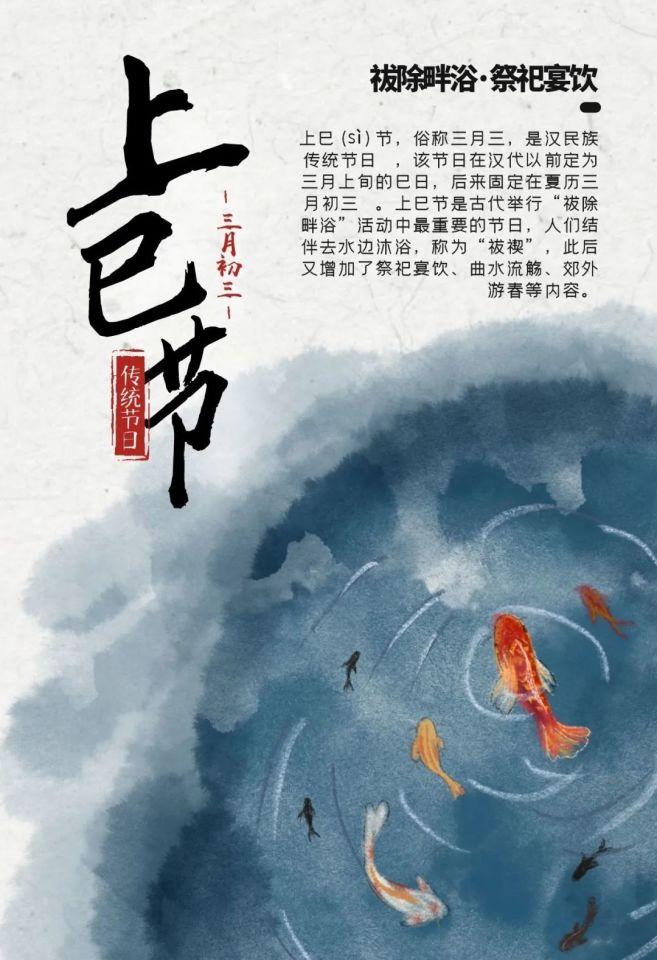
Like the Flower Dynasty Festival, the Shangwei Festival is also a traditional festival that has gradually been forgotten. But it was a very important festival in ancient times, and people would go to the water's edge to "take a bath" on this day, that is, to hold a ceremonial ritual on the water's edge to remove ominous rituals. This custom is called "祓(fú)禊(xì)".
And this day is not only the day of "Qi Yu", but also the birthday of the Yellow Emperor of Xuanyuan, the "Daughter's Day", and the oldest "Valentine's Day" in China.
The origin of the Shangwei Festival is very early, and the cultural heritage is also very strong. The earliest documentary records appear in the early Han Dynasty, when Zheng Xuan said in the Notes on the Zhou Li: "When the years were removed, now in March it is like water. At this time, the custom of going to court in March was popular in the court and in the folk. However, before the Wei and Jin Dynasties, the date of the Shangwei Festival was not fixed, it was on the day of the first three days of March, and after the Wei and Jin Dynasties, it was fixed on the third day of the first month of March.
Meandering water
After the Wei and Jin Dynasties, the significance of the Shangwei Festival was greatly weakened, and gradually evolved into a festival to welcome the spring. The Western Jin Dynasty's "Biography of the Emperor of Xia Zhong" described Luoyang at the time of Shangwei as "male Zhufu Yaolu, female Jinqi Yaolu". From this, another important custom of the Shangwei Festival is derived from this- the qushui flow, that is, "zen drinking".
By the Tang Dynasty, Shangwei had become one of the most solemn festivals of the time. In addition to hot spring bathing, the content of the festival is mainly spring travel and water feasting. Wu Zimu of the Song Dynasty wrote in the "Mengliang Record Volume II": "The Tang Dynasty gave a feast on the Qujiang River, pouring all the capital to drink and walk on the Green", which refers to the Tang Dynasty Shangwei Festival, where men, women and children in Chang'an City came out in full costume and feasted and drank on the banks of the Qujiang River. The Tang Dynasty poet Du Fu's "Li Ren Xing" also described the grand situation on the day of the festival: "On the third day of March, the weather is new, and there are many beautiful people on the water's edge of Chang'an. ”
After the Song Dynasty, the customs of the Shangwei Festival gradually declined, but some customs are still circulating. At the beginning of the Ming Dynasty, in order to show that he was having fun with the people, Zhu Yuanzhang would go out of the palace for a spring tour with the ministers on the third day of March.
Later, because the dates of the Shangwei Festival, the Cold Food Festival and the Qingming Festival were very close, and the custom of "祓禊" in the Shangwei Festival had been replaced by spring travel, which was also the main activity of the Qingming Festival, the three festivals were gradually merged together. On the third of March, the Shangwei Festival gradually faded out of the "stage" of the festival, but it is still circulating in the southwest region of the south. (Video 01) For example, the Songkran Festival held every March 3 in Dali, Yunnan Province, actually has the shadow of the Shangwei Festival.
So, what are the festival customs on this day of shangwei festival?
First of all, let's talk about the earliest custom of "Qi Yu". The biggest feature of the Shangwei Festival is that it is inseparable from water, and its original activity "祓禊" is actually bathing, and the history books record that during the Zhou Dynasty, a religious activity called "Zen Zen" was carried out on the march of the Shangwei Day. "祓" refers to the removal of sick qi, and "禊" refers to the purification of the body, so "祓禊" refers to the ritual of coating the body with herbs, washing the body, and expelling evil qi, which is used to achieve the purpose of eliminating disasters and diseases and praying for well-being.
There are also views that the custom of "praying" originated from the fertility worship activities of the ancestors. Because the ancients believed that water is a mysterious sensual substance, a woman bathing in the river can not only wash away the dust and dirt in winter, but also touch the water to feel pregnant and get a child.
But from a modern point of view, "Qi" is more like the ancients' spring health care to drive away evil spirits and dispel plague, because the river in winter is too cold, the water temperature in early March has risen, and people are eager to take the first bath after wintering.
After bathing, a refreshing body, in the warm spring sun, of course, and the green outing. From the previously mentioned record in the second volume of the "Record of Dreams", it can be seen that whenever it comes to the Shangwei Festival, it is a good time to step into the spring, and men and women come out of the city together, to pick orchids in the valley, or to feast and drink in the countryside.
Ceremony
What is the Festival of Shangwei?
What are the customs of this day?
What is the relationship between the Shangwei Festival and Wang Xizhi?